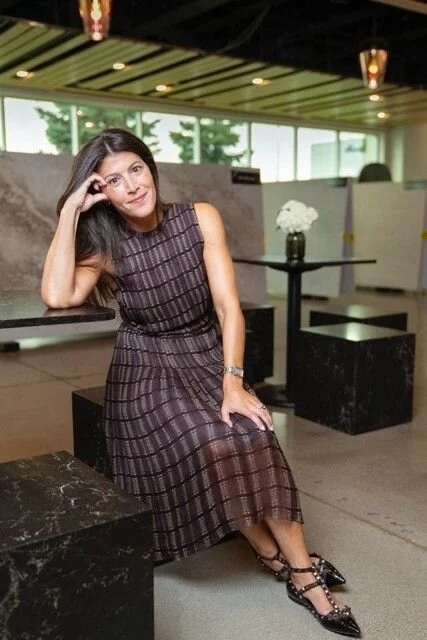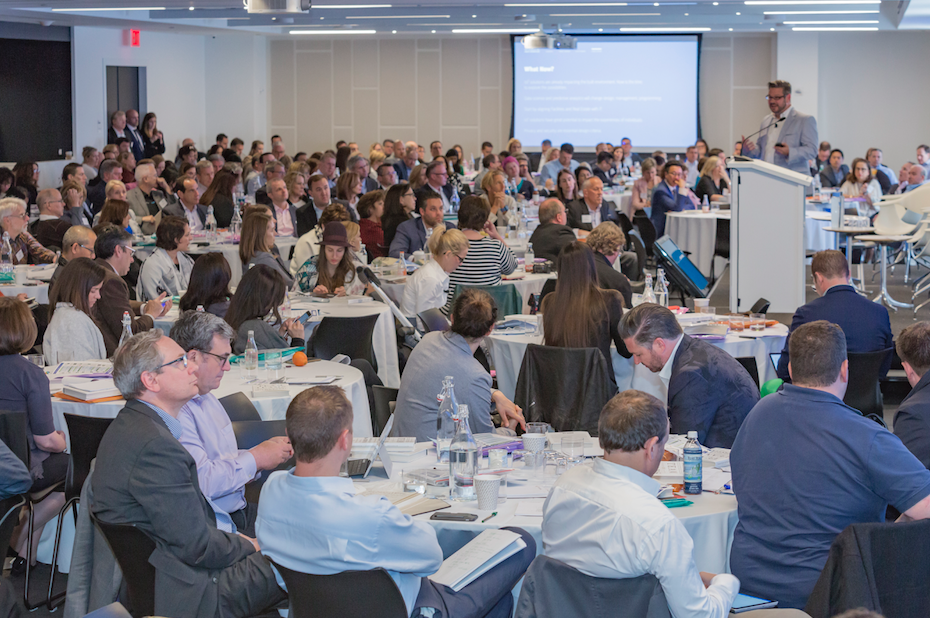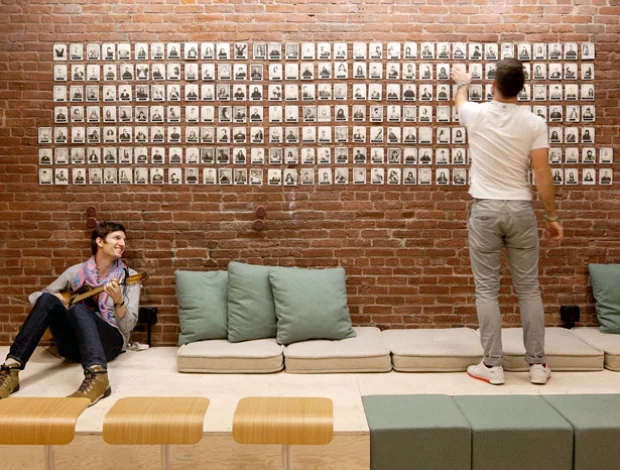At the offices of Yelp, Vice, and WeWork--and surely many other Millennial-centric startups--employees don't need to meet down the street at a local happy hour joint. Happy hour starts down the hall at the in-office bar. It's a trendy feature to have in the office--but it's also a huge liability if you don't know what you're doing.
Watch: CallisonRTKL Office Design for American Insurance Association
The American Insurance Association tapped CallisonRTKL to transition their office from a suburban office park to an urban, sustainable, collaborative home. The new office space increases employee collaboration through an open office plan and acts as a center that celebrates the past, present and future of the organization. Their new office design reflects AIA’s mission by creating an active environment that enables openness and transparency while maintaining their humble demeanor.
Bringing privacy to open plan offices
An open office can prompt collaboration—or awkward silence. When employees have nowhere to work privately, it’s time for a new look at workplace design.
Apple’s New Headquarters Is a Sign of Tech’s Boom, Bravado
Apple Inc. employees last month began testing the company’s latest innovation: Apple Park, one of history’s most expensive corporate campuses and the leading example of the tech industry’s newfound love for splashy architecture.
WHAT WE LEARNED AT WORKTECH 17 NEW YORK
WORKTECH 17 New York took place on May 4 at Convene’s 117 W. 46th Street location, attracting, as it’s wont to do, some of the biggest and brightest names in the workplace and technology industries to debate and discuss the future of work.
9 Ways to Build the Office of Tomorrow
When Boston Consulting Group (BCG) was looking to create a New York City headquarters with tomorrow in mind, they had a number of simultaneous objectives: How do you make a space inviting? How do you encourage BCG alumni in the area to stop by? To get nonprofit clients to hold board meetings at the new location? To encourage existing consultants on different projects to share ideas? Here's how BCG did it…
Virtual and augmented reality: The future of the workplace
Virtual and augmented reality are hitting the headlines for their ability to propel users into new environments or add new elements to games. But one of the most promising areas to be revolutionised will be the workplace.
When it comes to virtual and augmented reality, the former is already widely used by companies all over the world. There is, however, huge potential for both to revolutionise the office and upend workplace needs.
5 buildings designed to make you healthier
Architects increasingly embrace the idea that they play a role in fostering good health by designing buildings that make it easier for occupants to make positive lifestyle choices such as moving during the day, absorbing natural light and eating healthy food. POLITICO asked Matt Welker, who promotes healthy building design at the American Institute of Architects, to pick five of his favorite buildings and explain what makes them good at making you healthier.
VIDEO: A Culture of Creativity
With a rich history dating back to 1905, American Greetings was in need of a new headquarters that would carry the business into the next century. After deciding to relocate its 1,600 employees from Brooklyn to Westlake, Ohio, the company looked to CallisonRTKL to design a facility that would be an expression of their corporate culture and character, with both a deep respect for the American Greetings history and a view to the future of the industry. At over 60,000 SM, the new headquarters is a truly modern workplace with space for offices, meeting rooms, photo studios, showrooms and a large courtyard.
WHEN WORK HAS MEANING, THE WORKPLACE BECOMES A CULTURAL HUB
Humans are by nature creative. We’re makers, designers, producers, idea-generators. Creating is one of the things we humans are really good at—and our creativity is a big reason why we work.
Too many people today are disengaged from their work and show up only for the paycheck. But financial rewards are not the first things people look for in a career. A sense of purpose ranks much higher.
2 New Studies Reveal the Dark Side of Workplace Flexibility
Whether you look at polls of employees or Silicon Valley's obsession with perks like unlimited vacation days, it's clear that flexibility is the latest hot workplace benefit. Some commentators have even gone so far as to call flexibility the new definition of success.
There's plenty of reason to cheer this development. Studies show that flexibility reduces stress and can boost productivity, and on a human level having the ability to adjust your schedule to help an ailing relative or attend your kid's field trip is certainly nice. But while there's a compelling case to be made for workplace flexibility, that doesn't mean the idea is all upside, as two new studies illustrate.
Organisations out of step with workers in the digital workplace era
Although we now struggle to imagine living in a world without smartphones and the Internet, organisations appear to be slightly out of step with the digital era, according to a new study of their behaviour by Oxford Economics and Citrix. The research, published in a report called Building the Digital Workplace, measured progress toward digital work at organisations around the world. It found that there is a pressing need for organisations to develop a coherent digital strategy especially with regard to work. Although all the common concerns remain about security, costs and skills remain, the report suggests that firms need to do more to reap the benefits of a digital workplace. It cites the example of firms who have done most to develop a digital workplace strategy and the positive outcomes they have enjoyed.
A Case - and Space - for Connection
It happened again today. I saw a young couple eating together, with their heads down, phones in respective hands. They did not engage in any actual human-to-human correspondence, connection, or eye contact whatsoever. I did, however, overhear a whole lot of dings and beeps from their phones.
Is this what we've come to? Are the connections we make through our devices real? Do they empower us to actually gain new perspectives and make real, human-centered connections?
As we've pumped our schools and classrooms full of devices, have we unintentionally disconnected our children from one another?
Via ki.com
The right side of cool
There’s a lot of chatter about the “cool” office spaces we all envy a little – the ones with gaming areas, nap nooks and fully-stocked kitchens. But what is the line between a fun, collaborative office space and one that’s too lax and distracts employees from being productive?
Companies, of course, want to be perceived as established and financially healthy – and the amenities you offer employees can help you accomplish that, while creating the kind of atmosphere job-seekers envy. But you can’t just throw up a basketball hoop and tell your employees go play without some ground rules first. Before diving headfirst into the ballpit, so to speak, company leaders should ask themselves what they are trying to achieve with what they offer, and how they’re going to manage these spaces, as well as expectations.
GRAPHIC: How Herman Miller’s innovative office design led to the dreaded cubicle
Some 50 years ago, Herman Miller designers dreamt up the prototype for what eventually became the cubicle we know today. In it’s early stages, these open-plan office systems were designed to encourage movement and adjustability. Oddly enough, they were regarded as flexible and liberating. Over the decades, cubes lost site of the designers’ original aims. Now, roughly 60 percent of Americans use cubicles at work, with varying sizes, shapes, adjustability, and features.
Don’t stand so close to me: why personal space matters in the workplace
As successive BCO Specification Guides and the research of organisations like CoreNet Global have proved, the spatial dynamics of offices have changed dramatically in recent years. Put simply, the modern office serves significantly more people per square foot than ever before. Originally this tightening was largely down to the growing ubiquity of flat screen and the mobile devices, but more recently the major driver of change appears to be the gradual disappearance of personal workstations in favour of more shared space.The typical space allocated to an individual in a building has shrunk dramatically in the last few years, while the provision of public and meeting space has increased. The upshot is that the amount of personal space allocated to each individual in a building has fallen by over a fifth in just a few years and the very idea of using the number of employees to determine their individual space requirements without other considerations seems less relevant.
Why You Can’t Concentrate at Work
After taking down walls to create open offices and foster lots of interaction and collaboration, some companies are finding they’ve done the job too well. All of this social engineering has created endless distractions that draw employees’ eyes away from their own screens.
Visual noise, the activity or movement around the edges of an employee’s field of vision, can erode concentration and disrupt analytical thinking or creativity, research shows. While employers have long tried to quiet disruptive sounds in open workspaces, some are now combating visual noise too. The answer could be as low-tech as strategically placed plants or more drab wall colors.
Where is the office heading?
Is there too much co-working space? Has the super-stripped-back office had its day? With the British Council of Offices Conference taking place this week, the AJ asked some of the nation’s leading office designers for their answers
There are few better bellwethers of the state of the office development industry than the mood and topics of discussion at the annual BCO Conference.
Designing to Inspire Productivity
Work environments that are designed to make employees feel connected, functional and emotionally fulfilled can increase their productivity. Spaces that employees rejuvenate in can lead to an overall improved disposition. One of the findings in the Steelcase Global Report is that employee engagement correlates directly with workplace satisfaction.
The new normal arrives for the commercial property sector
Traditionally, the two principle vectors for change in the commercial property market have been lease lengths and space standards. Both have shrunk markedly over recent years, subject to the miniaturising effects of technological and cultural change. Even so, the effects of this contraction have taken place within an existing paradigm so have been easily understood, if not always acted upon.So it has been that major property organisations such as the British Council for Offices and CoreNet have been able to produce guides and reports based on well understood principles and without challenging the business models and assumptions of developers, landlords, workplace designers and occupiers. For most the challenges remained the same, not least how to resolve the sometimes conflicting timescales of people, place, property and technology that is the defining tension at the heart of office design and management.

























